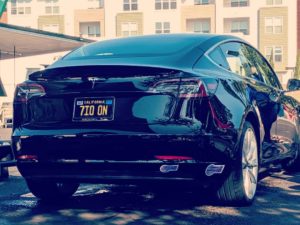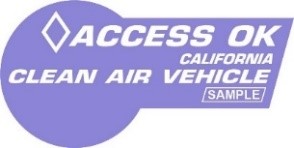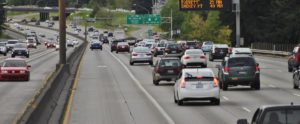Jack Brown July 9, 2019
 You finally did it! You got that plug in vehicle so you can use the carpool lane and get around some of that California traffic, but you should probably wait before you send in that application to maximize the use of the carpool lane.
You finally did it! You got that plug in vehicle so you can use the carpool lane and get around some of that California traffic, but you should probably wait before you send in that application to maximize the use of the carpool lane.
A History Driving Solo in the Carpool Lane
One of the great incentives with purchasing a qualifying plug in vehicle or hydrogen fuel cell vehicle is the ability to drive solo in the carpool lane provided you add carpool lane stickers to your vehicle. The California Clean Air Vehicle program started back in 2000 with a white sticker for electric and hydrogen vehicles. There were not many production freeway-speed capable vehicles at that time. GM had just killed the EV1 and a few Toyota RAV4 and Ford Ranger EV pickups were on the road. In 2004, the program was expanded with a yellow sticker for hybrids that made the Toyota Prius famous and use of the program became more apparent. In 2008, the Tesla Roadster pioneered modern production electric vehicles and the white sticker program began to take off. Starting in 2010 through 2013, the Nissan Leaf, BMW ActiveE, Ford Focus Electric and eventually the Tesla Model S began filling the HOV lane. In 2014, California introduced the green Clean Air Vehicle sticker for Enhanced Advanced Technology Partial Zero-Emissions (Enhanced AT PZEV) or Transitional Zero-Emission (TZEV) such as the Chevrolet Volt and Ford Fusion Energi.
Things Start Backing Up
WIth all these vehicles entering the market and gaining popularity, the HOV lane started filling up. At points, the HOV lane was becoming slower than the other lanes on the highway which violated federal standards. The Clean Air Vehicle program was set to expire on January 1, 2019, but in October of 2018, then Governor Jerry Brown signed into law AB-544 that extended the clean air vehicle program, but with rolling expirations. Essentially, clean air vehicles now get 3 full years of access plus the remainder of the year they applied for the stickers. All vehicles registered with CAV stickers prior to Jan 1, 2017 would have their white or green stickers expire on January 1, 2019. Those that registered after January 1, 2017 and prior to the issuance of the new red sticker would get a replacement red sticker that would expire on January 1, 2022. Those that registered after January 1, 2019 would receive a lavender sticker that would be valid through January 1, 2023.
Now Here is Why You Want to Wait!
 Let’s say you just bought your qualifying electric vehicle on June 30th and filled out the REG-1000 form to get your sticker and sent it to Sacramento along with your check for $22. There is currently an eight week backlog of applications awaiting approval from the DMV. With that eight week backlog, it means you will not get your lavender stickers until about September 1st giving you only 4 months of use in 2019 and the full 3 years of use in 2020, 2021 and 2022, or about 40 total months of use. Note you cannot reapply at the expiration for the same vehicle. Once you have your current set, that is all you get for that car.
Let’s say you just bought your qualifying electric vehicle on June 30th and filled out the REG-1000 form to get your sticker and sent it to Sacramento along with your check for $22. There is currently an eight week backlog of applications awaiting approval from the DMV. With that eight week backlog, it means you will not get your lavender stickers until about September 1st giving you only 4 months of use in 2019 and the full 3 years of use in 2020, 2021 and 2022, or about 40 total months of use. Note you cannot reapply at the expiration for the same vehicle. Once you have your current set, that is all you get for that car.
More Time in the Fast Lane
Now let’s say you wait until January 1, 2020 to send in your application. If the current backlog remains constant, you should receive your Clean Air Vehicle sticker (in a color to be announced) around March 1, 2020. This will allow for 10 months of use in 2020, along with 3 full years in 2021, 2022 and 2023! That’s at least 46 full months of use! Using this method will only work next year, 2020 and 2021. In 2022, the program is set to expire on September 30, 2025. People that apply for the stickers after January 1, 2022 will lose 3 months of use since the program ends on September 30, 2025 instead of the end of the year as with the current red and lavender stickers as well as the next two colors will receive. More detail can be found on the California Air Resources Board website.
Patience is a Virtue
 In all, a little extra waiting to get your stickers can buy you more time in the HOV lane. This is a unique time to use this trick. Current federal law allowing clean air vehicles to use HOV lanes with a single occupant expires on September 30, 2025 so future incentives are uncertain, Hopefully by that time, full self-driving vehicles will be available and we may not need to worry about what lane we are being driven in.
In all, a little extra waiting to get your stickers can buy you more time in the HOV lane. This is a unique time to use this trick. Current federal law allowing clean air vehicles to use HOV lanes with a single occupant expires on September 30, 2025 so future incentives are uncertain, Hopefully by that time, full self-driving vehicles will be available and we may not need to worry about what lane we are being driven in.
Jack Brown is the founder of Take Charge and Go. A blog dedicate to the issues of public EV charging infrastructure etiquette and new plug-in vehicle ownership considerations. His EV Charging Etiquette Survival Kit can be found on Etsy at bit.ly/ev-etiquette


